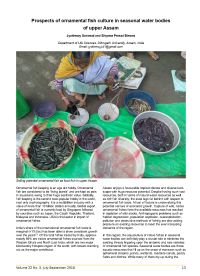Asian Aquaculture 2018 is dedicated to the sustained progress of aquaculture in the Asian region. The conference will provide a better understanding the systems practiced, highlighting regional needs and constraints within the global context of sustainable intensification of aquaculture. The conference is organised by and will be held at the Asian Institute of Technology, Thailand. Abstract submission and early bird registration is available until 30 September. Please visit the conference website for further information.
The 77th edition of the Quarterly Aquatic Animal Disease Report contains information from nine governments. The foreword discusses an intensive seven-day training course on tilapia lake virus (TiLV) that was jointly organised by China's National Fisheries Extension Center, Sun Yat-Sen University and the Food and Agriculture Organization of the United Nations.
In the ornamental fish markets of India, the euryhaline spotted scat Scatophagus argus and pearlspot Etroplus suratensis are popularly sold as ornamental fish. This article describes the nursing of wild-caught spotted scat seed and in-pond breeding of pearlspot to produce marketable sized fish at the Joykrishna hatchery and fish seed farm, located in the Hooghly River estuarine zone in coastal West Bengal, India. The fish are reared in brackishwater ponds for commercial utilisation as ornamental fish, supplying Hyderabad and other cities.
Makhana, Euryale ferox is a perennial aquatic herb with gigantic floating leaves that grows in still, shallow water. The sowing and harvesting of makhana seeds, a casual food for rural folk, is conducted by groups of migratory people belonging to the Mallah or Sahini community of Bihar. The makhana seeds are usually fallen and scattered over the bottom of the wetlands (beels) and must be collected manually by diving during September-November. The raw seeds sell for Rs. 60-70 per kg in Assam.
India’s share of the international ornamental fish trade is marginal but has been able to show consistent growth over the years. Of the total ornamental fishes traded by India, approximately 85% are native fishes sourced from the Western Ghats and North East India. The aquaculture of native fishes in seasonal water bodies can play a role in both conservation and generation of livelihoods. Imparting knowledge regarding ornamental fish trade and establishing market linkages is required to further develop the industry.



